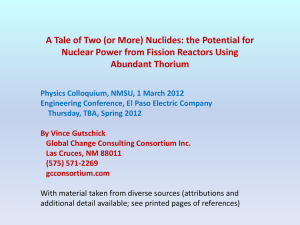Full Text
advertisement
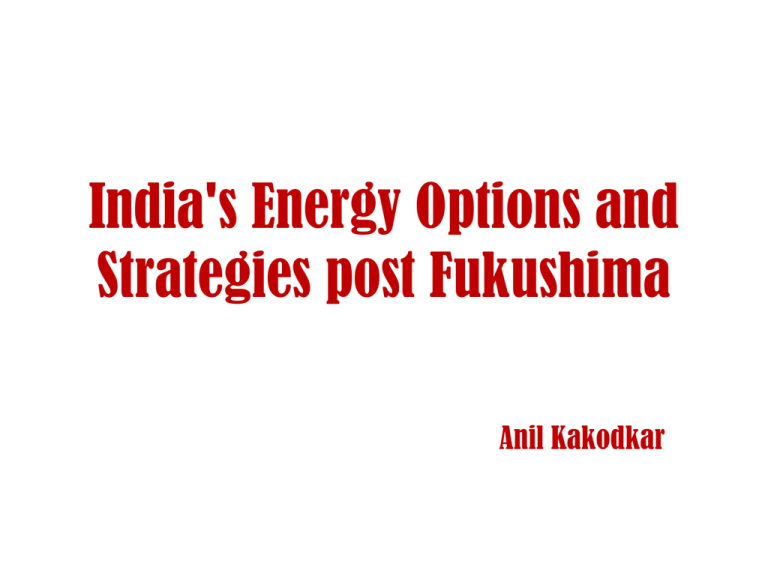
India's Energy Options and Strategies post Fukushima Anil Kakodkar Source: The Energy Challenge for Achieving the Millennium Development Goals, (UN-Energy, 2005) SOURCE: THE ENERGY CHALLENGE FOR ACHIEVING THE MILLENNIUM DEVELOPMENT GOALS, (UN-ENERGY, 2005) We need as much additional electricity as we produce today to provide a reasonable standard of living (~5000 kWh per capita) in the developing world Population (billions) World OECD 6.7 1.18 Annual Electricity Generation (trillion kWh) Carbon-di-oxide Emission (billion tons/yr) 18.8 10.6 30 13 Annual av. per capita ~2800 Electricity (kWh) ~9000 Non-OECD 5.52 8.2 17 ~1500 India alone would need around 40% of present global electricity generation to be added to reach average 5000 kWh per capita electricity generation Global average temperature over last one and a half century showing a more or less steady increase over the last fifty years or so. The fluctuations and their cycles can be correlated with various events like solar cycles . We do not know how close we are to the tipping point. However we need to act now to secure survival of our future generations. Current Indian Energy Resources 155502 156000 69 Renewables Nuclear Fossil 42231 154000 70 60 40000 50 30000 40 30 20000 20 10000 5833 Current 20 10 328 0 Years of rate depletion for (697 TWh) electricity generation by 2052 rate single source (7957 TWh) 10419 Effective Electricty Generation Potential of Renewables (GWe) Electricity Generation Potential in GWe-Yr of Indian Energy Resources (Fossil + Nuclear) (Ref: A Strategy for Growth of Electrical Energy in India, DAE, 2004; Coal data from Report of The Expert Committee on Road Map for Coal Sector Reforms) Uranium Plutonium 233Uin in Fast Thorium PHWRs Reactors based Reactors Coal Hydrocarbon 130 * 4.12 211 >1950 11.5 * 0.36 18.5 >170 Hydro Other Renewables excluding solar 0 Total Solar collection area required (based on MNES estimate 20 MW/km2) : At current rate- >>3900 sq. km At 2052 rate- >>44650 sq. km *: To be preferentially used in transport sector Chernobyl Consequences TOTAL DEATHS; 62 (47 PLANT, 15 DUE TO THYROID CANCER ) ACUTE RADIATION SYNDROME; 134 (OUT OF WHICH 28 HAVE DIED) INCREASED CANCER INCIDENCE; AMONG RECOVERY WORKERS THYROID CANCER; (CURABLE, WAS AVOIDABLE) 6000 ( 15 HAVE DIED) PROJECTED HEALTH CONSEQUENCES FROM VERY LOW DOSES TO LARGE SECTIONS OF POPULATIONS ARE QUESTIONABLE AN ESTIMATE IN 2006—93,000 WILL DIE DUE TO CANCER UP TO THE YEAR2056 ANOTHER ESTIMATE IN 2009---985,000 DIED TILL 2004 Energy Source Death Rate (deaths per TWh) Coal world average 161 (26% of world energy, 50% of electricity) Coal China 278 Coal USA 15 Oil 36 (36% of world energy) Natural Gas 4 (21% of world energy) Biofuel/Biomass 12 Peat 12 Solar (rooftop) 0.44 (less than 0.1% of world energy) Wind 0.15 (less than 1% of world energy) Hydro 0.10 (europe death rate, 2.2% of world energy) Hydro - world including Banqiao) 1.4 (about 2500 TWh/yr and 171,000 Banqiao dead) Nuclear 0.04 (5.9% of world energy) http://nextbigfuture.com/2011/03/deaths-per-twh-by-energysource.html Comparative Seismic Hazard Catastrophe syndrome • Low quantitative risk is not a good enough criteria • Maximum impact in public domain needs to be limited irrespective of the low probability Not withstanding Fukushima most countries are going ahrad with nuclear power ( USA, UK, France, Russia, China, Japan, Finland ---) The Indian Advanced Heavy Water Reactor (AHWR), a quick, safe, secure and proliferation resistant solution for the energy hungry world AHWR is a 300 MWe vertical pressure tube type, boiling light water cooled and heavy water moderated reactor (An innovative configuration that can provide low risk nuclear energy using available technologies) Major design objectives Significant fraction of Energy from Thorium Several passive features AHWR can be configured to accept a range of fuel types including LEU, U-Pu , Th-Pu , LEU-Th and 233U-Th in full core 3 days grace period No radiological impact Passive shutdown system to address insider threat scenarios. Design life of 100 years. Easily replaceable coolant channels. Top Tie Plate Water Tube Fuel Pin Displacer Rod Bottom Tie Plate AHWR Fuel assembly PSA Level 3 calculations for AHWR indicate practically no probability of impact in public domain Plant familiaisation & identification of design aspects important to severe accident PSA level-1 : Identification of significant events with large contribution to CDF Level-3 : Atmospheric Dispersion With Consequence Analysis SWS: Service Water System Release from Containment ECCS HDRBRK: ECCS Header Break APWS: Active Process Water System LLOCA: Large Break LOCA Level-2 : Source Term (within Containment) Evaluation through Analysis Level-1, 2 & 3 PSA activity block diagram SWS 63% SLOCA 15% Contribution to CDF MSLBOB: Main Steam Line Break Outside Containment Frequency of Exceedence -10 10-10 10 -11 -11 10 10 -12 10-12 10 -13 10-13 10 -14 -14 10 10 110 mSv -3 0.110Sv -2 10 Sv 1.0 -1 10 Sv 10 0 Thyroid Dose (Sv) at 0.5 Km Variation of dose with frequency exceedence (Acceptable thyroid dose for a child is 500 mSv) Iso-Dose for thyroid -200% RIH + wired shutdown system unavailable (Wind condition in January on western 11 Indian side) Reactor Block Components Peak clad temperature hardly rises even in the extreme condition of complete station blackout and failure of primary and secondary systems. Clad temperature (K) AHWR 300-LEU is a simple 300 MWe system fuelled with LEU-Thorium fuel, has advanced passive safety features, high degree of operator forgiving characteristics, no adverse impact in public domain, high proliferation resistance and inherent security strength. 600 10 sec delay 5 sec delay 2 sec delay 590 580 570 560 550 0 200 400 600 800 1000 Time (s) AHWR300-LEU provides a robust design against external as well as internal threats, including insider malevolent acts. This feature contributes to strong security of the reactor through implementation of technological solutions. Amount of Plutonium in spent fuel per unit energy (kg/TWhe) Reduced Plutonium generation High 238Pu fraction and low fissile content of Plutonium 30 238Pu Total Fissile 25 239Pu 240Pu 241Pu 242Pu 20 MODERN LWR 15 10 5 0 MODERN LWR AHWR300-LEU 238Pu 3.50 % 238Pu 9.54 % 239Pu 51.87 % 239Pu 41.65 % 240Pu 23.81 % 240Pu 21.14 % 241Pu 12.91 % 241Pu 13.96 % 242Pu 7.91 % 242Pu 13.70 % AHWR300-LEU The French N4 PWR is considered as representative of a modern LWR.. The reactor has been referred from “Accelerator-driven Systems (ADS) and Fast Reactor (FR) in Advanced Nuclear Fuel Cycles”, OECD (2002) STRONGER PROLIFERATION RESISTANCE WITH AHWR 300-LEU MUCH LOWER PLUTONIUM PRODUCTION Much Higher 238Pu & Lower Fissile Plutonium The Presence of 232U in uranium from spent fuel 232U 233U 234U composition of the fresh 235U 236U as well as the 238U spent fuel of AHWR300-LEU MODERN LWR % 232U 0.02 % 0.00 % 233U 6.51 % 234U 0.00 % 234U 1.24 % 235U 0.82 % 235U 1.62 % 236U 0.59 % 236U 3.27 % 238U 98.59 % 238U 87.35 % 232U 0.00 233U Uranium in the spent fuel contains about 8% fissile isotopes, and hence is suitable to be reused in other reactors. Further, it is also possible to reuse the Plutonium from spent fuel in fast reactors. AHWR300-LEU makes the fuel cycle inherently proliferation resistant. Mined uranium per unit energy produced (Tons/TWhe) 20 15 10 5 0 PHWR MODERN AHWR300-LEU LWR AHWR300-LEU provides a better utilisation of natural uranium, as a result of a significant fraction of the energy is extracted by fission of 233U, converted in-situ from the thorium fertile host. With high burn up possible today, LEU-Thorium fuel can lead to better/comparable utilisation of mined Uranium Present deployment Of nuclear power Uranium Thorium Enrichment Plant LEU Thorium fuel LEU Thermal reactors Reprocess Spent Fuel For growth in nuclear generation beyond thermal reactor potential Safe & Secure Reactors For ex. AHWR Fast Reactor Recycle 233U Thorium Nuclear power with greater proliferation resistance LEUThorium Thorium MOX Thorium Reactors Recycle For ex. Acc. Driven MSR Thorium Sustainable development of energy sector Transition to Fossil Carbon Free Energy Cycle GREATER SHARE FOR NUCLEAR IN ELECTRICITY SUPPLY REPLACE FOSSIL HYDROCARBON IN A PROGRESSIVE MANNER RECYCLE CARBONDIOXIDE Fossil Energy Resources ENERGY CARRIERS Carbon/ Hydrocarbons Electricity Electricity (In storage or transportation) • Electricity • Fluid fuels (hydrocarbons/ hydrogen) Hydrogen Sun Nuclear Energy Resources CH4 Fluid Hydro carbons chemical reactor Biomass WASTE • CO2 • H2O • Other oxides and products CO2 CO2 DERIVE MOST Nuclear Recycle OF PRIMARY ENERGY Sustainable Waste Management Strategies THROUGH SOLAR & Urgent need to reduce use of fossil carbon in a progressive manner NUCLEAR Other recycle modes Thank you Strategies for long-term energy security Required import: The deficit coal is practically * in 2050 1.6 billion wiped outtonne in 2050 1400 1300 1200 No LWRimported import: reactor/fuel 40 GWe Period: 2012-2020 7 GWe Deficit 412 GWe FBR using spent fuel from LWR Installed capacity (GWe) 1100 1000 900 800 Deficit to be filled by fossil fuel / LWR imports 700 LWR (Imported) Nuclear (Domestic 3-stage programme) Projected requirement* 600 500 Hydrocarbon Coal domestic 400 300 200 Non-conventional 100 Hydroelectric 0 2010 2020 2030 Year * - Assuming 4200 kcal/kg 2040 *Ref: 2050 “A Strategy for Growth of Electrical Energy in India”, document 10, August 2004, DAE
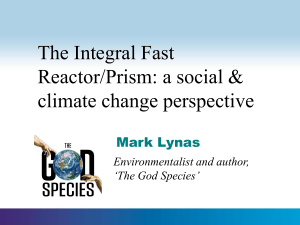
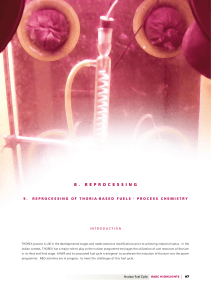
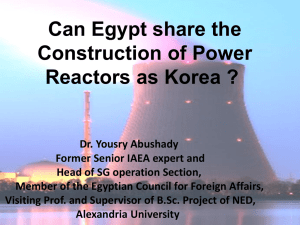
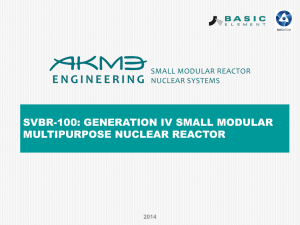
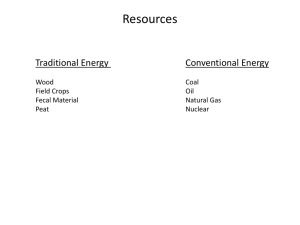
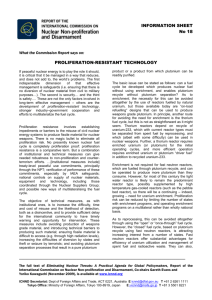

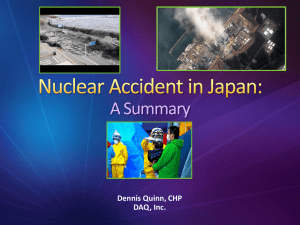
![The Politics of Protest [week 3]](http://s2.studylib.net/store/data/005229111_1-9491ac8e8d24cc184a2c9020ba192c97-300x300.png)

